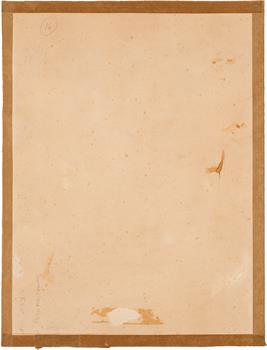4140
Kurt Schwitters
(Hannover 1887 - 1948 Kendal, Westmorland)
„Untitled (D'Cilly)“
1941/1942
collage, paper and gauze on paper; framed
32 x 18.7 cm (image), 41.7 x 32 cm (original support carton)
Provenance
Walter and Marga Dux, London (gift of the artist);
private property, Merano, to 1995 (inheritance or gift);
since then private collection, Italy/Austria
Exhibition
2000/2001 Hannover/Düsseldorf/Munich, Aller Anfang ist Merz - von Kurt Schwitters bis heute, Sprengel-Museum Hannover, 20.08.-05.11.2000/Kunstsammlung Westfalen Düsseldorf, 25.11.2000-18.02.2001/Haus der Kunst München, 09.03.-20.05.2001, no. 173
Literature
Susanne Meyer-Büser (ed.)/Karin Orchard (ed.), Aller Anfang ist Merz - von Kurt Schwitters bis heute, (exhibition catalogue, Sprengel-Museum Hannover/Kunstsammlung Westfalen Düsseldorf/Haus der Kunst Munich, Hannover/Düsseldorf/Munich 2000/2001), Ostfildern-Ruit 2000, no. 173, ill. p. 166;
Karin Orchard/Isabel Schulz, Kurt Schwitters - catalogue raisonné, vol. 3, edited by Sprengel-Museum Hannover, Ostfildern-Ruit 2006, no. 2822, p. 312 (with b/w-ill.)
Reserve Price: € 50.000 +fees +if applicable Droit de Suite
The same fees apply for bids at the reserve price as during the auction and a knockdown can take place immediately after processing.Estimate: € 35.000 - 70.000
Kurt Schwitters, the “grandmaster of collage” (https://www.tate.org.uk/whats-on/tate-britain/schwitters-britain, accessed 4.10.2023), was probably one of the most influential artists of the early 20th century. Rejecting conventional genres, he not only developed his oeuvre in the atmosphere of Dadaism, but also borrowed from Surrealism and Constructivism. This gave rise to his own completely unique art form, which he called “Merz”, which is often wrongly interpreted as synonymous with the term “Dada” but is in fact an independent stylistic orientation.
From 1919 onwards, Kurt Schwitters used the term “Merz”, originally taken from a collage in a commercial bank advertisement, for his assemblages of newspaper cuttings, advertisements and waste products. At the same time, a wide range of possible associations with rhyming words such as “Kommerz”, “ausmerzen”, “Scherz”, “Herz” as well as “März” (“March”), which stands for a new beginning, open up. Subsequently, “Merz” writings and “Merz” buildings are created.
Already ostracised as “degenerate” early on in his career, Kurt Schwitters emigrated to Norway in 1937 and fled from the German occupiers to England in 1940. After being interned in various camps, he settled in London at the end of 1941. It was here that he created the “Merz” picture “D'Cilly”, in which he creates a collage over a photograph of a portrait of Franz Defregger. Clippings from fashion magazines, London bus timetables and a handwritten address slip have likewise been used here, as has part of a picture of a fellow artist. It could well be a detail of a work by his friend Ben Nicholson and shows Kurt Schwitters’ close relationship to Constructivism and Abstraction-Création. Cilly’s eyes have been left out, so that amidst the wildly collaged parts, the girl gazes intensely at us as if through a slit. This motif was not chosen at random: Franz Defregger, a representative of the Munich School, is probably a symbol of the representational, historicising painting that must be surmounted. Kurt Schwitters uses the collaged parts like the brushstrokes of a painting, thus creating a dense composition that “has grown out of laws as strict as those of nature” (Kurt Schwitters quoted on: https://beruhmte-zitate.de/autoren/kurt-schwitters/, accessed on 4.10.2023). “Merz” art negates everything known up to that time, desires “liberation from every fetter” (Kurt Schwitters, see above), and thus prepares fertile ground for the coming generations of artists.
(Sophie Cieslar)



